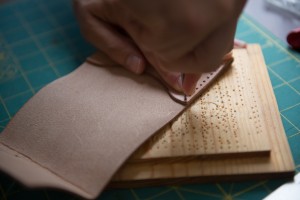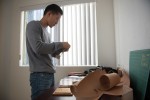On a balmy Saturday afternoon, the third-year mechanical engineering student is hard at work – back hunched, gaze focused and callused hands tense.

He then takes the knife and digs it into a sheet of camel-colored leather.
Stephen Yonsik Lee has been handcrafting leather goods in his dorm room and new apartment for a year to quench his yearning for handwork. Starting with the design and selection of leather for cardholders, wallets and laptop cases, there is no process in leather crafting that he does not do himself.
“I like doing things with my hands,” Lee said. “I didn’t know I would like it so much. I just dipped my feet into something and it became a passion.”
Before he could make leather goods upon personal request, he was teaching himself how to chain-stitch and cut leather through YouTube videos and do-it-yourself books.
He recently set up a website with his roommate, Ryan Yoo, a third-year ethnomusicology and communication studies student, where he plans to sell select leather goods for around $25 to $50.
Lee first started dabbling with leather out of curiosity and a craving for making things with his hands.
He said he decided to study mechanical engineering because he expected his classes to be hands-on. But he said he was disappointed to find they focused more on theory than applied mechanics.
“I just wanted to make something,” Lee said. “So, I thought, ‘This year I’m going to make a blog and do a lot of do-it-yourself projects.’ It was a spur-of-the-moment thing.”
Soon, he found himself dissecting and restitching a fake Louis Vuitton wallet his brother had bought for him from Cambodia. The experiment led his eyes to set on a leather bracelet and $150 portfolio case, which he wanted but couldn’t afford.
He ended up making a portfolio by himself, investing eight hours, $40 on leather and $50 on tools after reading books on metallurgy and leather crafting.
“It feels good knowing that you can do it. It feels better knowing that I can make (leather goods) and sell them,” Lee said.
Jonathan Hong, a third-year economics student and Lee’s roommate said he was surprised to learn about Lee’s hobby when he walked in the room with a giant roll of leather.
“He was just messing around and he eventually made a wrist band in the shape of a knife. I wouldn’t have thought of anything like that,” Hong said. “You could just ask him to make something, and he’d make anything.”
While working in his Westwood apartment, Lee is slow and steady with the knife, which he takes around the edges of the rectangular poster board to cut the leather beneath it into the same shape.
With his eyes pinned to the edge of the knife, he proceeds to etch the silhouette of a cardholder onto the piece of leather.
He takes the freshly cut pieces to the kitchen and starts hammering the tough leather slab into submission to make it smoother. The clash of metal onto leather drowns the jazz beats that flow in his apartment.
He said most of his inspiration for design comes from observing and analyzing leather goods made by his favorite designers and brands like Isaac Reina and Tanner Goods.
“I look at (them) from every angle. Observe how they stitched it, how they burnished it,” he said. “Thinking what makes them look good and what doesn’t.”
Lee said he considers himself a perfectionist when it comes to leather goods. He starts from scratch if his product is not up to par with his exacting standards of what makes a quality leather good.
“I’m such a perfectionist. It’s such a burden. I don’t like to look back at what I made. It pains me. I look back and it’s an eyesore,” he said.
Despite Lee’s talent in leather crafting, his parents were at first against the idea of him making leather goods.
They thought he was wasting time and told him to drop leather-making and focus on his studies, Lee said.
“He would do it until late at night. I was worried it would interfere with his studies,” said Paul Lee, Stephen Lee’s father. “And looking at his friends (who study art), the drawing and crafting process seemed very difficult. They seemed stressed. And it would be hard to get a job (in that field).”
However, Paul Lee said he now understands how his son’s talent in leather crafting can help him develop his creativity, which both Stephen Lee and his father think is crucial to mechanical engineering.
“It’s important for engineers to keep in mind concepts of design,” Stephen Lee said. “Circuits are organized in a way to be most efficient. Everything has to fit into place. Being efficient, minimalistic, it all comes to design.”
Design is one of many components Lee is looking to refine, he says as he takes the needle back and forth through the stitching marks he etched on to the leather slab.
“I look for cleanliness. Stitching has to be straight. Edges have to be finely burnished. Cuts have to be clean, sanded, smooth,” he said. “It has to look good and have (a) function.”
Lee said he is unsure where his interest in leather crafting will take him in the future, but said he believes positive results will follow if he chases his passion.
He sheepishly pushes the finished cardholder forward and apologizes for the slit that is a little too close to the edge of the cardholder.
“I will make you an entirely new one if it breaks,” he said.
